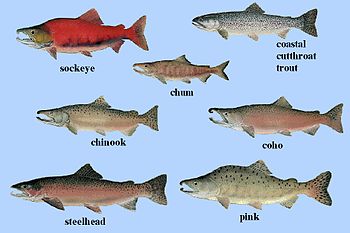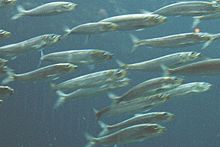
Overview Fish contain heart-boosting omega-3 fatty acids and many other nutrients that make them a vital part of a person's diet. All fish, however, contain some level of the element mercury, which is poisonous to the human body when ingested in large amounts. Because some fish contain more mercury than others, it is important to be aware of mercury levels and how much of a fish you can eat. Significance Mercury is a naturally occurring element in nature. It does not naturally occur in lakes and streams, however. Rather, it is generated by industrial pollution and emitted into the air. The mercury then falls and begins to build up in streams and oceans. When this occurs, the mercury turns into methylmercury, which is harmful to people--especially pregnant mothers and their unborn children. Because fish and shellfish live in these waters, they naturally absorb the methylmercury. Not all fish absorb methylmercury in the same manner, which is why some fish are more dangerous than others to eat. Warning Fish that live the longest and are the largest tend to have the highest amounts of mercury content. Because these fish have had a longer time to accumulate mercury, they contain highly concentrated amounts of mercury expressed in parts per million or PPM. These fish include mackerel king (0.730 PPM); shark (0.988 PPM); swordfish (0.976 PPM); or tilefish (1.450 PPM), according to the U. S. Food and Drug Administration. For this reason, these fish should not be consumed by children or women who are pregnant or may be pregnant in order to avoid harmful effects from mercury, according to the Environmental Protection Agency. Time Frame Other forms of fish contain lower amounts of mercury and are considered safe for consumption. However, those in a higher-risk category--such as pregnant women or children--should only eat amounts up to 12 ounces, which is typically the equivalent of two meals per week, according to the American Heart Association. These fish include shrimp (below detection levels), canned light tuna (0.118 PPM), salmon (0.014 PPM), pollock (0.041) and catfish (0.049 PPM), according to the U. S. Food and Drug Administration. Each fish contains low levels of mercury, but still should not be eaten more than twice per week by those in the higher-risk category. Considerations Other forms of fish may contain only moderate amounts of mercury and should be consumed at six servings or less per month, according to the National Resources Defense Council. These include Alaskan cod, halibut (Pacific), lobster, mahi mahi, freshwater perch, skate, snapper and tuna. If women are planning on becoming pregnant or are nursing, they should not consume these fish. Effects Excessive consumption of mercury has been associated with conditions such as brain damage and seizures, according to the Public Broadcasting System. Mercury also has been shown to cause birth defects, learning problems and lowered intelligence in children and unborn fetuses. A child may experience symptoms such as red cheeks, nose and lips; hair loss; kidney failure; or insomnia. Adults may notice symptoms such as swelling, peeling skin and persistent burning or itching of the skin.
Packed with protein and brain-boosting omega-3 fatty acids, fish is a nutritional powerhouse---yet high mercury concentrations in some species can pose a threat to health. Because developing fetuses are particularly susceptible to damage from mercury, pregnant women should remain cautious when eating seafood. Consuming species with the lowest levels of mercury is a safe way to reap the nutritional benefits of fish without endangering your unborn child. Which Fish Are Safe to Eat While Pregnant?
Salmon
 Principal Pacific salmon species: sockeye, chum, coastal cutthroat trout, chinook, coho, steelhead and pink
-------------------------------------------------------------------------------------------
Famous for its rich concentration of omega-3 fats, salmon is not only nutritious: it's also one of the safest species of fish for pregnant women to consume. The U.S. Food and Drug Administration (FDA) lists a mercury level of 0.014 parts per million for fresh and frozen salmon, an amount considered acceptable for all members of the population---including pregnant women. Although slight variations in mercury content exist between farmed and wild salmon, the level for both varieties is low enough to avoid fetal damage. Sardines
 Like salmon, sardines are a species of oily fish high in omega-3 fatty acids and low in mercury. According to the FDA, these fish contain a mercury concentration of only 0.016 parts per million---low enough for safe consumption during pregnancy. Because sardines are eaten whole rather than boned, they also provide ample levels calcium, a nutrient particularly critical for pregnant women. Pollock Pollock, a sweet-tasting marine fish, is another safe species to consume during pregnancy. With an FDA-reported mercury concentration of 0.041 parts per million, pollock poses little threat to a developing fetus. The American Pregnancy Association recommends eating no more than 12 oz. of pollock per week---an amount roughly equaling two meals. Canned Light Tuna 
Although tuna has rightfully earned a reputation for being high in mercury, canned light tuna is one of the few varieties low in this toxin. The FDA reports a mercury concentration of 0.118 parts per million for canned light tuna, whereas other types---such as bigeye tuna---contain nearly six times as much. According to the American Pregnancy Association, pregnant women may safely consume up to six 6-oz portions of canned light tuna per month. Anchovies

Boasting a distinctive flavor and high levels of omega-3 fatty acids, anchovies are both healthy and safe for pregnant women. The FDA lists their mercury concentration at 0.043 parts per million, making a weekly consumption of up to 12 oz acceptable for moms-to-be. Like sardines, anchovies are eaten whole, and their soft bones provide a rich source of calcium for both pregnant women and their fetuses. |
what's Pollock in Malayalam?
ReplyDelete